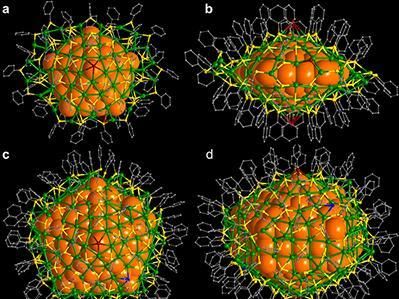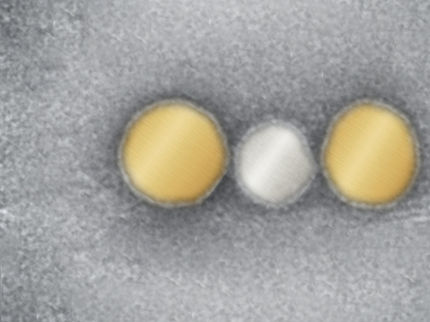Researchers synthesize atomically precise diamond-shaped nanoclusters of silver
Advertisement
A wide international collaboration involving researchers from four countries - China, Australia, Germany and Finland - have managed to synthesize and characterize two previously unknown, record-large silver nanoclusters of 136 and 374 silver atoms. These diamond-shaped nanoclusters (see Figure), consisting of a silver core of 2 to 3 nanometers and a protecting layer of silver atoms and organic thiol molecules, are the largest ones whose structure is now known to atomic precision.

This figure shows: Upper row: (a) top and (b) side view of the 136-atom silver nanocluster. Lower row: (c) top and (d) side view of the 374-atom silver nanocluster. The metal cores of these clusters have a diameter of 2 and 3 nm, respectively. Silver atoms in the metal core are denoted by large orange sphere. The core is protected by a silver-thiol layer (gre silver; yellow: sulfur; carbon: gray). Courtesy of Nanfeng Zheng, Xiamen University.
the University of Jyväskylä
The nanoclusters where synthesized in Xiamen University in China and characterized by X-ray crystallography and electron microscopy in China, Australia and Germany. Their electronic structure and optical properties were studied computationally in the Nanoscience Center (NSC) of the University of Jyväskylä in Finland.
Gold nanoclusters that are stabilized by a thiol molecular layer have been known for decades, but only during the latest years silver clusters have attracted more interest in the research community. Silver is a desirable material for nanocluster synthesis since it is a cheaper metal than gold and its optical properties are better controllable for applications. However, synthesis recipes that would produce silver clusters that are stable for prolonged times are not so widely known as for gold.
"These largest atomically precise silver nanoclusters known thus far serve as excellent model systems to understand how silver nanoparticles grow," says Professor Nanfeng Zheng whose research group prepared the clusters in Xiamen University in China. "The internal structure of the metal core is a combination of little crystallites of silver that are joined together to form a five-fold symmetric diamond-shape structure."
"From a theoretical point of view these new clusters are very interesting," says Academy Professor Hannu Häkkinen from the NSC in Jyväskylä. "These clusters are already big enough that they have properties similar to silver metal, such as strong absorption of light leading to collective oscillations of the electron cloud known as plasmons, yet small enough that we can study their electronic structure in detail. Much to our surprise, the calculations showed that electrons in the organic molecular layer take part actively in the collective oscillation of the silver electrons. It seems possible to then activate these clusters by light in order to do chemistry at the ligand surface."
Original publication
Huayan Yang, Yu Wang, Xi Chen, Xiaojing Zhao, Lin Gu, Huaqi Huang, Juanzhu Yan, Chaofa Xu, Gang Li, Junchao Wu, Alison J. Edwards, Birger Dittrich, Zichao Tang, Dongdong Wang, Lauri Lehtovaara, Hannu Häkkinen & Nanfeng Zheng; "Plasmonic twinned silver nanoparticles with molecular precision"; Nature Comm.; 2016





























































